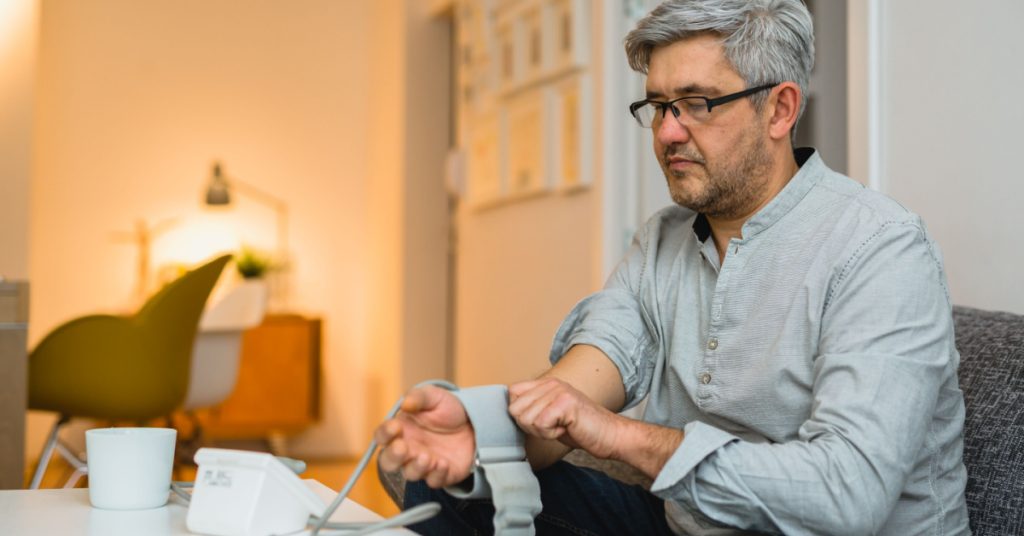How to Check Blood Pressure at Home: The Ultimate Guide
Less than half (48%) of Americans between the ages of 50 and 80 with a blood pressure-related condition monitor their blood pressure (BP) at home. Of those who do not check their blood pressure, a significant number may lack the knowledge to do so effectively.
Keeping a regular check on your blood pressure is crucial, especially when dealing with conditions like hypertension. However, it’s not just about checking – it’s about doing it right. You need to have the right equipment and know the correct methods to accurately measure your blood pressure.
This comprehensive guide will walk you through everything you need to know about home blood pressure monitoring, so let’s get started.

Master your heart health now
Take part in our 60sec quiz and get a heart health plan tailored just for you.
Contents
Why Measure Blood Pressure at Home?
In most countries, you can get your blood pressure reading done at a pharmacy or shopping mall. And no matter where you live, you can rely on your doctor to get it checked, too.
So why should you measure your blood pressure at home? There are quite a few good reasons:
- Checking blood pressure readings at home has been linked to better BP control. A 2018 study was able to show a drop in systolic pressure from an average of 152mmHg to 137mmHg after 12 months.
- Using a home blood pressure monitor puts a patient in better control of their health. This can help with confidence, particularly when it comes to their self-management.
- Measuring your blood pressure at home is more convenient than leaving the house to get your readings. You’re more likely to do it regularly instead of putting it off.
- Checking your own blood pressure is also more cost-effective.
Necessary Equipment for Home Blood Pressure Monitoring
If you’re aiming to measure your blood pressure at home, you’ll only need a blood pressure monitor.
Blood pressure monitors come in two types: digital and manual. A digital blood pressure monitor does all the work for you once you press the start button – all you need to do is wear the cuff.
A manual (aneroid) monitor, on the other hand, is more complicated. You’ll have to wear the cuff, inflate it manually, and use a stethoscope to listen carefully for your blood pressure reading.
It is generally preferable to use digital blood pressure monitors when you measure your blood pressure at home. For instance, a digital monitor like the Cardi Health BP Monitor is portable and eliminates the risk of human error.
Start managing your heart health now!
Find out what works for you with this 60sec quiz.

Features to consider when buying a blood pressure monitor
When looking for a home blood pressure monitor, there are a few things to consider:
- For most people, digital monitors are a preferable option for self-measured blood pressure readings. There’s less skill needed for accuracy.
- Choose a device with a blood pressure cuff that is worn around the upper arm. BP monitors that take blood pressure measurements from the wrist are likely to be less accurate.
- Aim for a BP monitor that supports storing your blood pressure measurement on the device’s memory.
How to buy the right cuff size
When measuring blood pressure, the right cuff size is crucial – an inappropriately sized cuff can lead to inaccurate blood pressure readings.
But don’t worry; determining the right cuff size for you is actually quite simple. Grab yourself a tape measure and follow these steps:
Find the halfway point of your upper arm.
Wrap the tape around this point to get the circumference of your upper arm in centimeters.
Compare the measurement of your arm to the list below to find your cuff size.
- Arm circumference (cm): 22–26, cuff size: small adult
- Arm circumference (cm): 27–34, cuff size: adult
- Arm circumference (cm): 35–44, cuff size: large adult
- Arm circumference (cm): 45–52, cuff size: extra-large adult
Preparing for Blood Pressure Measurement

To get the most accurate blood pressure reading, there are a few things you can do before and while using your BP monitor.
Here are some of the tips you can follow:
- Make sure you don’t have a full bladder. A full bladder can lead to higher readings.
- If possible, have your blood pressure checked in a quiet, calm location.
- Make sure you’ve had the chance to sit quietly for at least 5 minutes before taking your blood pressure.
- Avoid using any stimulants within 30 minutes of checking your blood pressure. For example, caffeine-containing drinks and nicotine can increase your blood pressure.
- If possible, avoid eating anything during the 30 minutes before your measurement.
- The ideal position for measuring your blood pressure is sitting in a chair with your back at rest. Also, have both feet flat on the floor.
- Avoid talking during the measurement.
How to Check Blood Pressure at Home: Step-by-Step
You can easily monitor your blood pressure in two steps: positioning and wearing the cuff, as well as taking the actual measurement. Don’t worry, it’s easier than you think!
Step 1: Positioning and setup
Find a comfortable chair and sit with your back against the chair and your feet flat on the floor.
Have a table or surface at chest height on which to rest your forearm. The BP monitor will be on the same table, at chest level.
Using an appropriately-sized cuff, tighten it on the bare skin of your arm, about one inch above the elbow. The arm cuff should be tight enough not to slip around, but not too tight.
Check the inside of the cuff as it will indicate where the sensor is – it should typically be on the front inside of your arm.
Finally, stretch the same arm out in front of you on a table or desk with the palm facing up
Step 2: Taking the measurement
It is time to check your blood pressure. Wait a few seconds before pressing the start button on your digital monitor. It will turn on, and the cuff will begin to inflate.
The cuff will become very tight around your bare arm, but it won’t hurt before it begins to deflate slowly.
Once this is done, the display screen will show your blood pressure numbers. The top number is your systolic pressure, and the bottom number is your diastolic pressure.
You can now record these readings if you wish.
Interpreting Blood Pressure Readings
If you have high blood pressure, it’s especially important to know what the normal range is. Now that you know your systolic and diastolic pressures, you may be wondering what these numbers mean and how to interpret them.
Your systolic pressure is the pressure of your blood flow against the walls of your blood vessels when the heart squeezes to pump.
Diastolic pressure is the pressure when the heart is relaxed before the next pump.
Normal blood pressure is a systolic blood pressure reading below 120mmHg and a diastolic blood pressure reading below 80mmHg.
While it’s great to know what a normal reading looks like, you also need to know what makes for high blood pressure, or hypertension, reading. The list below, from the American Heart Association, dives into this.
- Systolic pressure: <120mmHg; diastolic pressure: <80mmHg; blood pressure type: normal
- Systolic pressure: 120–129mmHg; diastolic pressure: <80mmHg; blood pressure type: elevated
- Systolic pressure: 130–139mmHg; diastolic pressure: 80–89mmHg; blood pressure type: Hypertension Stage 1
- Systolic pressure: >140mmHg; diastolic pressure: >90mmHg; blood pressure type: Hypertension Stage 2
If you check your blood pressure and it is in the Elevated range, lifestyle changes can help with control, but you should visit your doctor to be on the safe side.
If you have stage 1 or stage 2 high blood pressure, consult a healthcare professional as soon as possible. This will let you get started on blood pressure medications sooner.
Maintaining a Blood Pressure Log

Once you know how to check blood pressure at home, you can check your BP at any given time. However, it is also important to understand how your blood pressure varies over time. Keeping a blood pressure log makes this possible.
Your doctor can use this to assess spikes, figure out the causes, and adjust your management. They can also look out for low blood pressure readings.
Traditionally, your log could be kept in a notebook, but digital apps and platforms make it easier to record multiple readings. The Cardi Health app, for instance, can help you keep track of your BP over time and makes it easy to share with your healthcare team.
When logging BP, register every accurate reading into the app shortly after taking it.
Frequency of Home Blood Pressure Monitoring
Initially, with home monitoring, you’ll aim to check your blood pressure twice daily at the same times each day. The best time to measure your blood pressure is either in the morning or in the evening. Later, the frequency may be reduced based on your doctor’s advice.
You must take at least two readings each time you check your blood pressure. Make sure they are about one minute apart. If you get a reading that is unusually higher than the previous one, take it again.
You may end up with two or three readings, but if one is very different, you can ignore it.
Start managing your heart health now!
Find out what works for you with this 60sec quiz.

Comparing Home Measurement With Medical Office Readings
Always strive to let your doctor check your BP and compare it with your readings from home monitoring. If your doctor gets high readings, it might be down to “white-coat hypertension.”
This is when the hospital setting or being around a doctor causes increased readings. Measuring your blood pressure can help inform your healthcare workers of accurate values.
If your BP is considered normal at home, you won’t need any kind of treatment.
How to Measure Blood Pressure at Home: Key Takeaways

Regular home blood pressure monitoring is convenient, cost-effective, and has been proven to improve your blood pressure measurements and self-management.
It is important to keep tabs on your BP through regular monitoring and logging, using your medication as prescribed, and embracing lifestyle modifications like increased physical activity and dietary changes.
And, of course, don’t forget to visit your doctor for your regular checkups to make sure that you’re always at your very best.
Start managing your heart health now!
Find out what works for you with this 60sec quiz.

Related articles
Best Foods to Lower Cholesterol
Does Caffeine Raise Blood Pressure?
Does Drinking Water Lower Blood Pressure?
Causes of High Blood Pressure at Night
10 DASH Diet Breakfasts for a Healthy Start
Heart-Healthy Diet Guide
What Should an 85-Year-Old Blood Pressure Be?
What is Normal Blood Pressure for a 70-Year-Old?
How to Read Blood Pressure: A Comprehensive Guide
Manage your heart health now
Find out what works best for you with this 60sec quiz and get your personalized heart health plan.

